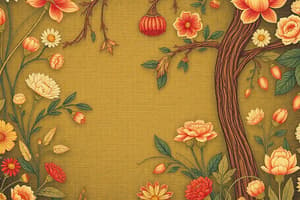Podcast
Questions and Answers
What does the term 'art' relate to in Latin?
What does the term 'art' relate to in Latin?
ars
What are the three main categories of defining art?
What are the three main categories of defining art?
- Representation
- Expression
- Form
- All of the above (correct)
Representation or mimesis is the only measure of artistic value today.
Representation or mimesis is the only measure of artistic value today.
False (B)
Who first developed the idea of art as 'mimesis'?
Who first developed the idea of art as 'mimesis'?
What movement emphasized emotional expression in art?
What movement emphasized emotional expression in art?
Which of the following is NOT a principle used to define art as form according to Immanuel Kant?
Which of the following is NOT a principle used to define art as form according to Immanuel Kant?
According to H.W. Janson, how should we view works of art?
According to H.W. Janson, how should we view works of art?
The earliest symbolic scribblings of mankind are considered to be art today.
The earliest symbolic scribblings of mankind are considered to be art today.
Art can convey the full spectrum of the human experience through peaceful means, as it serves as a symbol for something that is _____ .
Art can convey the full spectrum of the human experience through peaceful means, as it serves as a symbol for something that is _____ .
Match the artists with their quotes about art:
Match the artists with their quotes about art:
Flashcards are hidden until you start studying
Study Notes
Ways of Defining Art
- Art lacks a universal definition but is generally understood as the conscious creation of beauty and meaning using skill and imagination.
- Historical and cultural contexts influence the value and definition of art.
- The term "art" originates from the Latin word "ars," with early usage traced back to the 13th century.
Categories of Art Definition
-
Art as Representation (Mimesis):
- Coined by Plato, denoting art as an imitation or copying of reality.
- Historically valued based on faithful representation, especially before the late 18th century.
- Great masters like Michelangelo and Velásquez exemplify high-value representational art.
-
Art as Expression:
- Emerged during the Romantic movement, focusing on conveying emotions and audience responses.
- Aims to evoke specific feelings in viewers, holding relevance in contemporary practices.
-
Art as Form:
- Immanuel Kant advocated assessing art solely based on formal qualities, disregarding concepts or content.
- Formalism gained importance with the rise of abstraction in the 20th century, impacting art evaluation based on design principles.
Art and Context
- Art definitions evolve as they are contextualized within historical settings and societal circumstances.
- From the 11th to 17th centuries, skill and knowledge were paramount in defining art, particularly during the Dutch Golden Age.
- The Romantic period expanded definitions to encompass emotion and beauty, contrasting with Enlightenment rationalism.
Avant-Garde and Modern Art
- The Avant-garde movement began in the 1850s with realism and progressed through cubism, surrealism, and futurism.
- Emphasizes originality and innovative expression, resulting in diverse modern genres like digital, performance, and conceptual art.
Perspectives on Art
- Diverse definitions of art exist, influenced by individual viewpoints and experiences.
- Notable quotes highlight different understandings of art, such as its mysterious nature, its emotional capacity, and its role in civilization.
The First Artist
- Early human symbolic expression, including cave paintings, represents the transition from primitive to modern consciousness.
- Art signifies what it means to be human, facilitating communication of thoughts, emotions, and concepts through tangible forms.
- Symbolism in art reflects the quest for understanding life’s mysteries and human experience.
Activity & Reflection
- Engage with various artworks through practical classification (mimesis, expression, form) to deepen understanding.
- Reflect on personal interpretations of art using quotes from renowned artists and theorists to contextualize individual experiences.
Studying That Suits You
Use AI to generate personalized quizzes and flashcards to suit your learning preferences.




